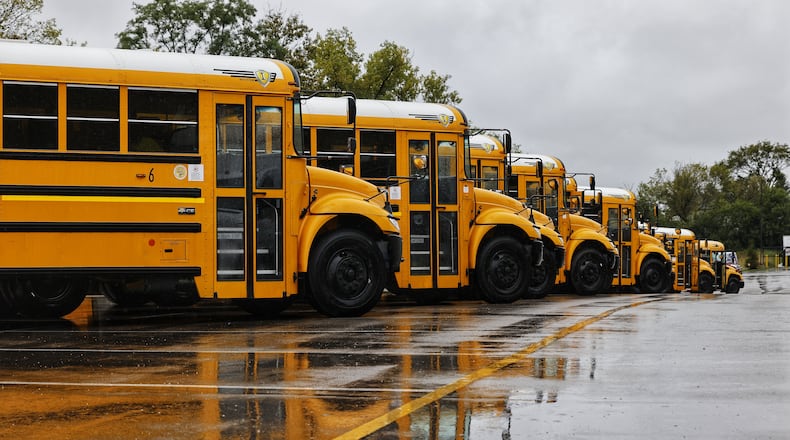Districts with contracted bussing providers get to forego the responsibility of hiring their own bus drivers and instead rely on companies like Petermann or FirstStudent to ensure their students can reliably get to school.
Petermann-serviced districts, which includes Lakota, Middletown, Talawanda, Monroe and Madison, will all have enough drivers to get students back to school, according to Edward Flavin, the vice president of external communications for Petermann.
Though, that doesn’t necessarily mean that all those districts are comfortably staffed, or that they won’t have to change bussing routes in order to make do with fewer drivers.
Bill Westerbeck, the transportation director for Fairfield City School District, explained that getting kindergarteners, elementary students, middle schoolers and highschoolers to-and-from school requires a reliable and licensed full-time bus driver for each route.
Each driver, in theory, runs one route per school. If that driver misses a day, districts need to have several substitute drivers who can step in at a moment’s notice. Otherwise, Westerbeck said, students can be left “standing.”
“You can’t leave kids standing,” Westerbeck said. “We’re not here to leave kids standing, we’re here to get them to school.”
For the county’s in-house districts, which includes Edgewood City Schools, Hamilton City Schools, Ross Local School District and Fairfield City Schools, that responsibility falls squarely on the district.
Fairfield, which also provides bussing to several non-public schools outside its district, is short on both full-time and substitute drivers. Westerbeck said the district could use 11 more full-time drivers to fulfill its routes from last year, along with 10 more part-time drivers in order to feel comfortable.
Westerbeck said his district is scrambling to cover routes. The district has 6,800 kids that ride the bus every day and 75 full-time routes.
“We’ll be changing routes, we’ll have to juggle routes, we’ll have to tear some routes apart… we’ll have to double routes up,” Westerbeck said. “We’ll do whatever we can do to get the kids to and from school.”
Westerbeck said optimizing routes when dealing with driver shortages is like a “big chess game,” especially when it comes to overtime. He aims to avoid OT, in part because he doesn’t want to work his drivers too hard, but also because it’s not an efficient way to use taxpayer dollars. But, sometimes, he’ll have to dip in to OT just to make it all work.
“Knock on wood, we’ve not had to ever tell a parent, ‘There’s not a bus available for you.’ Somehow, someway, we try to figure out how to get it covered,” Westerbeck said.
Part of the shortage, at least for Fairfield — which is spread thin in a more severe way this school year than any other — is an aging, retiring workforce.
“Every year you have a few, but this past year we had quite a few retirees come in,” Westerbeck said. “On top of the fact that we were [already] running a little short, then we had a lot of retirees come in, [and] it just compounded the issue.”
Pam Theurer, a spokesperson for Edgewood City Schools, which is another in-house district, said they have been spared from a major retiree exodus this past year.
“We’ve been very fortunate, it’s not been that bad for us,” Theurer said. “Right now, we have a sufficient number of drivers. What our problem is is usually sub drivers.”
Theurer said Edgewood lost some substitute drivers during the height of COVID, and that the current trend of higher cases might discourage more drivers from filling those roles. Theurer explained that some substitute drivers for Edgewood are retirees looking for part time work and found value in the job.
Theurer and other Edgewood officials believe that part of the substitute driver shortage is mirrored and exacerbated by hiring issues across the board: Everywhere is hiring, everywhere is trying to sweeten the deal, and substitute bus drivers can only pull from a niche pool of people — those who don’t need a full-time, consistent gig but still want to work.
“I think we’re probably just facing the same challenges that everyone else is, and we’ll kind of battle through that,” Theurer said.
Additionally, substitute drivers have to obtain the same certifications as full-time drivers — proper training, a commercial driver’s license, a clear background check. Westerbeck said the training process can take four to six weeks. And, of course, the pay can be lower too.
Currently, in Fairfield, full-time drivers start at $20.28 an hour, while part-timers start at $18.50. Westerbeck said the district has increased these starting wages in order to stay competitive. Fairfield is also trying to make it easier for drivers to come into the fold by offering paid training for new hires.
But, these issues aren’t confined to in-house districts. Flavin said Middletown City Schools and Lakota Local School District — while staffed enough to get through the year — are the two Petermann districts that would benefit the most from more drivers.
“We’ll be watching that closely, but we could always use more,” Flavin said.
“I think we’re all running on shortages, whether it’s a contractor or whether it’s an in-house district,” Westerbeck said. “I think it’s just a shortage across the board.”
The Cincinnati-headquartered First Student — the largest school transportation provider in North America and the bussing provider for New Miami Local School District — launched a hiring initiative earlier this month to bring more drivers into the company.
The company said in a press release that it will provide paid training, competitive wages, benefits, and nights, weekends and holidays off, adding that it’s “...an ideal job for stay-at-home parents and retirees.”
About the Author

